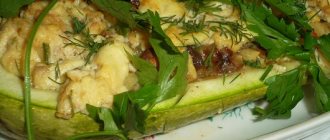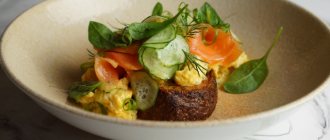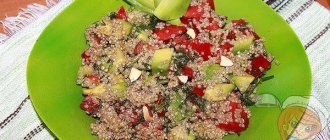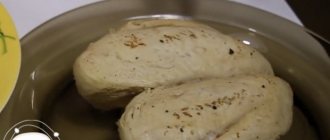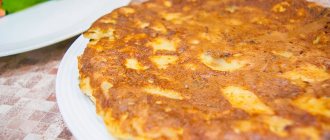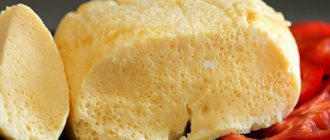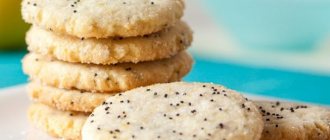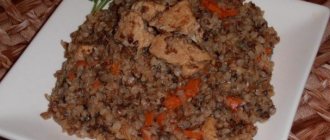Tuna is a large fish, reaching 3-4 meters in length, with red meat that tastes and textures similar to beef (in France it is called “veal of the sea”). It is prepared in all possible ways - fried, baked, boiled, stewed, dried, smoked. Meat is added to salads, sandwiches, pizza, rolls, sushi, and prepared as an independent dish. It is rich in omega-3 and omega-6, calcium, phosphorus, iodine, 80% of the daily value of B12, and about 30% of the daily value of vitamin B6.
Grilled tuna is a delicious and flavorful dish. To make it juicy, the meat is left a little raw inside (when fully fried, it becomes dry and tough). Due to the fact that the fillet does not undergo complete heat treatment, you need to be especially careful when choosing a product. Fresh fillets should have a uniform dark red color. Brown spots and uneven coloring are a sign of staleness. If you choose a whole carcass, pay attention to the skin (it should be light), the condition of the fins (intact) and the smell (pleasant oceanic). You can store fish in the refrigerator for no more than 4 days.
Grilled tuna recipe
This grilled tuna recipe calls for two medium 2-3cm thick ocean tuna steaks. To give tuna a pleasant aroma, a fairly simple bouquet of spices is used. It will require:
- 1 teaspoon fennel;
- 1 hour spoon of coriander;
- a pinch of black pepper;
- a pinch of sea salt.
It is better to use fresh meat in the recipe, but if you only have access to frozen steak, defrost it first at room temperature. The recipe is as simple as possible - grind all the spices and salt in a mortar, coat the steak with oil, roll the pieces of fish in the spices and set aside for a few minutes while the coals are prepared. Next, the grilled tuna is placed on the grill and cooked until medium rare.
The cooking recipe may also include a marinating step. As a marinade, you can use a variety of mixtures of spices, oils and sauces, here are two options to choose from:
- soy sauce, olive + sesame oil, honey, orange juice, any 2-3 spices to taste;
- red wine, garlic, dried herbs, fresh ginger.
Calories in Grilled Tuna. Chemical composition and nutritional value.
Nutritional value and chemical composition of “Grilled Tuna”.
The table shows the nutritional content (calories, proteins, fats, carbohydrates, vitamins and minerals) per 100 grams of edible portion.
| Nutrient | Quantity | Norm** | % of the norm in 100 g | % of the norm in 100 kcal | 100% normal |
| Calorie content | 205 kcal | 1684 kcal | 12.2% | 6% | 821 g |
| Squirrels | 20 g | 76 g | 26.3% | 12.8% | 380 g |
| Fats | 14 g | 56 g | 25% | 12.2% | 400 g |
| Water | 68.98 g | 2273 g | 3% | 1.5% | 3295 g |
| Ash | 1.96 g | ~ | |||
| Vitamins | |||||
| Vitamin A, RE | 22 mcg | 900 mcg | 2.4% | 1.2% | 4091 g |
| Retinol | 0.022 mg | ~ | |||
| Vitamin B1, thiamine | 0.134 mg | 1.5 mg | 8.9% | 4.3% | 1119 g |
| Vitamin B2, riboflavin | 0.137 mg | 1.8 mg | 7.6% | 3.7% | 1314 g |
| Vitamin B4, choline | 77.6 mg | 500 mg | 15.5% | 7.6% | 644 g |
| Vitamin B5, pantothenic | 0.334 mg | 5 mg | 6.7% | 3.3% | 1497 g |
| Vitamin B6, pyridoxine | 1.038 mg | 2 mg | 51.9% | 25.3% | 193 g |
| Vitamin B9, folates | 2 mcg | 400 mcg | 0.5% | 0.2% | 20000 g |
| Vitamin B12, cobalamin | 2.35 mcg | 3 mcg | 78.3% | 38.2% | 128 g |
| Vitamin D, calciferol | 2 mcg | 10 mcg | 20% | 9.8% | 500 g |
| Vitamin D3, cholecalciferol | 2 mcg | ~ | |||
| Vitamin E, alpha tocopherol, TE | 0.29 mg | 15 mg | 1.9% | 0.9% | 5172 g |
| Vitamin K, phylloquinone | 0.1 mcg | 120 mcg | 0.1% | 120000 g | |
| Vitamin RR, NE | 22.07 mg | 20 mg | 110.4% | 53.9% | 91 g |
| Macronutrients | |||||
| Potassium, K | 527 mg | 2500 mg | 21.1% | 10.3% | 474 g |
| Calcium, Ca | 4 mg | 1000 mg | 0.4% | 0.2% | 25000 g |
| Magnesium, Mg | 42 mg | 400 mg | 10.5% | 5.1% | 952 g |
| Sodium, Na | 54 mg | 1300 mg | 4.2% | 2% | 2407 g |
| Phosphorus, Ph | 333 mg | 800 mg | 41.6% | 20.3% | 240 g |
| Microelements | |||||
| Iron, Fe | 0.92 mg | 18 mg | 5.1% | 2.5% | 1957 |
| Manganese, Mn | 0.013 mg | 2 mg | 0.7% | 0.3% | 15385 g |
| Copper, Cu | 43 mcg | 1000 mcg | 4.3% | 2.1% | 2326 g |
| Selenium, Se | 108.2 mcg | 55 mcg | 196.7% | 96% | 51 g |
| Zinc, Zn | 0.45 mg | 12 mg | 3.8% | 1.9% | 2667 g |
| Essential amino acids | |||||
| Arginine* | 1.671 g | ~ | |||
| Valin | 1.438 g | ~ | |||
| Histidine* | 0.822 g | ~ | |||
| Isoleucine | 1.287 g | ~ | |||
| Leucine | 2.27 g | ~ | |||
| Lysine | 2.565 g | ~ | |||
| Methionine | 0.827 g | ~ | |||
| Threonine | 1.224 g | ~ | |||
| Tryptophan | 0.313 g | ~ | |||
| Phenylalanine | 1.091 g | ~ | |||
| Nonessential amino acids | |||||
| Alanin | 1.689 g | ~ | |||
| Aspartic acid | 2.86 g | ~ | |||
| Glycine | 1.34 g | ~ | |||
| Glutamic acid | 4.168 g | ~ | |||
| Proline | 0.988 g | ~ | |||
| Serin | 1.14 g | ~ | |||
| Tyrosine | 0.943 g | ~ | |||
| Cysteine | 0.3 g | ~ | |||
| Sterols (sterols) | |||||
| Cholesterol | 47 mg | max 300 mg | |||
| Fatty acid | |||||
| Trans fats | 0.02 g | max 1.9 g | |||
| Saturated fatty acids | |||||
| Saturated fatty acids | 0.205 g | max 18.7 g | |||
| 12:0 Lauric | 0.002 g | ~ | |||
| 14:0 Miristinovaya | 0.01 g | ~ | |||
| 15:0 Pentadecane | 0.004 g | ~ | |||
| 16:0 Palmitinaya | 0.127 g | ~ | |||
| 17:0 Margarine | 0.005 g | ~ | |||
| 18:0 Stearic | 0.054 g | ~ | |||
| 20:0 Arakhinovaya | 0.002 g | ~ | |||
| 22:0 Begenovaya | 0.001 g | ~ | |||
| 24:0 Lignoceric | 0.001 g | ~ | |||
| Monounsaturated fatty acids | 0.138 g | min 16.8 g | 0.8% | 0.4% | |
| 14:1 Myristoleic | 0.001 g | ~ | |||
| 15:1 Pentadecene | 0.002 g | ~ | |||
| 16:1 Palmitoleic | 0.014 g | ~ | |||
| 17:1 Heptadecene | 0.002 g | ~ | |||
| 18:1 Oleic (omega-9) | 0.099 g | ~ | |||
| 20:1 Gadoleic (omega-9) | 0.009 g | ~ | |||
| 22:1 Erucic (omega-9) | 0.002 g | ~ | |||
| 24:1 Nervonic, cis (omega-9) | 0.01 g | ~ | |||
| Polyunsaturated fatty acids | 0.175 g | from 11.2 to 20.6 g | 1.6% | 0.8% | |
| 18:2 Linolevaya | 0.023 g | ~ | |||
| 18:3 Linolenic | 0.002 g | ~ | |||
| 20:2 Eicosadiene, Omega-6, cis, cis | 0.002 g | ~ | |||
| 20:3 Eicosatriene | 0.003 g | ~ | |||
| 20:4 Arachidonic | 0.018 g | ~ | |||
| 20:5 Eicosapentaenoic acid (EPA), Omega-3 | 0.015 g | ~ | |||
| Omega-3 fatty acids | 0.127 g | from 0.9 to 3.7 g | 14.1% | 6.9% | |
| 22:4 Docosatetraenoic acid, Omega-6 | 0.002 g | ~ | |||
| 22:5 Docosapentaenoic acid (DPA), Omega-3 | 0.005 g | ~ | |||
| 22:6 Docosahexaenoic acid (DHA), Omega-3 | 0.105 g | ~ | |||
| Omega-6 fatty acids | 0.043 g | from 4.7 to 16.8 g | 0.9% | 0.4% |
The energy value of grilled tuna is 205 kcal.
Primary Source: Created in the application by the user. Read more.
** This table shows the average levels of vitamins and minerals for an adult. If you want to know the norms taking into account your gender, age and other factors, then use the “My Healthy Diet” application.
Useful tips
Proper preparation of grilled tuna is impossible without following the rules of processing, marinating, frying and temperature/time requirements. To cook fish as tasty as possible, follow a few useful tips:
- Steaks are best suited for grilling; the thickness of the piece should not be more than 3cm;
- the finished meat flakes on top, but remains pink inside;
- the longer the meat is marinated, the softer and juicier it turns out, the average marinating time is 0.5-2 hours, marinating up to 4 hours is acceptable;
- Before marinating, steaks must be washed and dried with a paper towel;
- To prevent the fish from sticking, grease the grate or grill surface with vegetable oil;
- to achieve an original crust, before frying, you can brush the steaks with whipped egg whites and bread them in sesame seeds with coriander and other spices;
- It is recommended to use medium temperature for cooking - the coals should become “gray”, while the palm raised above the coals should not tolerate the heat;
- The frying time for a piece 1.5 cm thick is 4-6 minutes; as the thickness increases, the cooking time also increases.
The dish goes well with vegetables, mushrooms, potatoes, rice, and lettuce. You can add garlic, cream, tomato, pesto or teriyaki as sauces.
Cold smoking
The process takes longer, the recipes are more complex, and special equipment is also required. A smoke generator, a smoke pipe and a smoking chamber are required. Despite the confusing names, everything is not that complicated. The point is that the smoke must cool before reaching the product. It is important to create conditions for drying fish in this haze. Smoking temperature – 25-30°C. A portable stove can serve as a smoke generator, and a tin pipe can serve as a chimney. Any lockable box or barrel will fit under the smoking chamber. Having assembled the structure, you can start cooking.
The criteria for selecting raw materials are the same as for the hot smoking method. When cutting, you need to take into account the nuances of recipes. The fillet is cut into pieces 2.5-3 cm thick. It is necessary to separate the boneless bellies from the carcasses and remove the skin from them.
Recipe for fillet with honey and ginger
Cold smoking dries out the meat a little, and the meat becomes slightly tough. A sauce with ginger and honey will help soften cold-smoked tuna. For this method you need:
- 1.5 kg fillet;
- sauce;
- wood chips
The main components of the sauce are water, salt, honey, ginger. The remaining ingredients are added to taste. The original composition is as follows:
- water at room temperature – 0.5 l;
- coarse salt – 2 tsp;
- honey – 200 g;
- chopped ginger root - 2 tbsp. l.;
- ground black pepper - half a teaspoon;
- soy sauce – 0.4 l;
- finely chopped garlic - 1 medium-sized head;
- cayenne pepper - on the tip of a knife.
Prepare as follows:
- Grind salt, ginger, garlic, pepper in a mortar, add honey, stir thoroughly.
- Combine with water and soy sauce.
- Pour the resulting mixture over the fish and leave in the refrigerator for a day.
- Remove the fillet from the marinade, let the liquid drain, and dry.
- Light the fire, place the raw materials in the smokehouse. Cook for 3 hours with the door barely open.
- Place in a small container with water, close tightly, and continue smoking for the same amount.
It is better to keep the resulting product for a couple of hours for complete fermentation.
Recipe with tummies
The belly is the tender but also the fattiest part of the tuna. Therefore, when preparing it, it is better to use a natural activator of fat breakdown - pineapple. The following products are required:
- tuna trimmings (tummies) – 2 kg;
- soy sauce – 500 ml;
- pineapple juice – 500 ml;
- finely chopped fresh ginger – 50 g;
- ground black and red pepper - 1 tablespoon each.
How to prepare and smoke:
- Mix pineapple juice, soy sauce, ginger root, pepper.
- Pour the marinade over the bellies and place in the refrigerator for 12 hours.
- Drain the liquid, place the fish pieces on a mesh and dry.
- Place in a heated smoking chamber and keep for 12 hours at 30°C.
- Place on a net and dry for the same amount of time.
Baked tuna (steaks): cooking recipes with photos
Oven-baked fish retains the maximum amount of vitamins and microelements. That is why it is recommended to cook tuna this way. Recipes in the oven (any novice housewife can please their family with steaks) describe in detail the entire process from marinating to actual cooking. Below are three such recipes.
- To prepare the next dish you will need 4 fresh steaks of optimal thickness. To begin, prepare a marinade of honey and lemon juice, soy sauce (3 tablespoons each) and pepper in a deep plate. Thanks to soy sauce, no salt is added to the marinade. The steaks are laid out in a single layer, poured with marinade and covered with a lid for 20 minutes. Then the fish is laid out on foil, poured with marinade and sealed. Cooking time in an oven preheated to 180 degrees is 15 minutes in covered foil and another 10 minutes after printing the sheet.
- Tuna cooked in the oven in foil is always juicy and tender. According to the recipe, dry the steaks with a paper towel, rub with a mixture of salt and pepper and place on a sheet of foil greased with vegetable oil. Before baking, sprinkle the steaks with lemon juice. After this, each sheet of foil should be sealed tightly and placed on a baking sheet, after pouring a little water on it. Tuna in foil will cook in the oven for about 30 minutes at 180 degrees.
- Tuna steaks (800 g) are rubbed with a mixture of salt, pepper and fish spices (1/2 teaspoon each) and placed in a baking dish. Top the steaks with chopped garlic (3 cloves) and poured with vegetable oil (120 ml). Next, the mold is covered with a lid (or foil) and placed in an oven preheated to 180 degrees for 10 minutes. Then the steaks are turned over to the other side and continue to bake for another 10 minutes.
cooking method
Tuna is one of the most famous and beloved types of fish. It has exceptional taste. In addition, tuna is a leader in protein content, which is so beneficial for the human body. People also call this fish “sea beef.”
Despite the fact that this fish does not live in our latitudes, it increasingly appears on the shelves of fish stores and in specialized departments of the supermarket. You can buy both individual parts of tuna carcass (the fish are usually large) and ready-made chopped fish steaks, which is undoubtedly very convenient for the consumer.
First of all, you need to thoroughly rinse the fish pieces under cool running water. Next, wipe them dry with paper towels or napkins. If the tuna steaks are frozen, they must first be thawed at room temperature.
In a separate bowl, combine extra virgin olive oil and lime juice. Add sea salt and dry spices to your taste. Lime juice can be replaced with lemon juice. This will, of course, change the taste of the marinade a little, but lemon also goes well with this fish.
Read also: Chips with paprika photo
Place the tuna steaks in a tight sealed bag and pour the previously prepared marinade into it. Then close (or tie) the bag tightly and, turning in different directions, cover the entire area of the fish steak with marinade.
Place the bag of tuna steaks in the refrigerator for about half an hour. During this time, the fish will absorb all the juices of the marinade, which will make its meat softer, more tender and, undoubtedly, richer in taste.
After the specified time has passed, you can begin to directly bake the fish steaks on the grill. Before placing the fish on the grill, you need to remove it from the marinade bag. Shake off the remaining marinade with sharp movements - it will no longer be needed. And fry the tuna over medium heat for 5 minutes on each side until deliciously golden brown.
It is best to serve tuna steaks with herbs, vegetables and even fruits. For example, it goes perfectly with all types of citrus fruits.
Grilled tuna
Featured Products.
Past purchases. New items Discounts. We work around the clock. Don't be afraid to eat raw tuna - in Japan it is considered the cleanest fish that does not have parasites. It turns out really very tasty, juicy and soft tuna, although I cook it on a grill pan. Please clarify, does “marinate” mean simply rolling it in marinade? Or leave it in the marinade for an hour?
Type of dish fish dishes Type of processing grilled Purpose for dinner today Kitchen step-by-step recipes good Uncomplicated. You will need Tuna steak in Delicatesk for RUR g buy 0 Coarsely ground black pepper in Delicatesk for RUR 1 tbsp.
About the recipe Tuna steaks grilled over charcoal - what could be more original and unusual at a family barbecue! Tip Tuna is called underwater veal due to the fact that the meat is dense and red. How to cook Thaw tuna steak naturally on the bottom shelf of the refrigerator on the drain.
Dry with a paper towel. Marinate in olive oil, ground coriander and a mixture of pepper and salt for minutes. Fry on a hot grill for 1.5 minutes on each side. The meat inside should remain red.
Recipe from Jamie Oliver
To prepare Jamie Oliver's Italian grilled tuna recipe, you need to select the following ingredients:
- 2 tuna steaks, each weighing approximately 150-180 g.
- Olives – 1 handful.
- Garlic – 2 cloves.
- Tomatoes – 200 g.
- Fresh basil, preferably green, to taste.
- Lemon – 1 piece.
- Dry oregano – 1 tsp.
- Olive oil.
- Sea salt.
- Pepper to taste.
- Anchovies – 3 pcs.
Nutritional value:
- Calorie content – 150 kcal.
- Proteins – 20 g.
- Fats – 8 g.
- Carbohydrates – 5 g.
Oliver advises following the following sequence of actions in the recipe:
- First you need to heat the olive oil in a frying pan.
- Season the steak pieces with salt, pepper and oregano and fry in a frying pan or electric grill for no more than 2 minutes on each side.
- After this, remove the fish and put it on a plate.
- Cook the olives - cut into small pieces.
- Finely chop the garlic.
- Wash the tomatoes and cut into several pieces.
- Tear the basil into large pieces with your hands.
- Add more oil to the pan and add garlic and olives. Fry for about 2 minutes, add tomatoes, simmer for 5 minutes.
- Squeeze half the lemon juice and add basil.
- Chop the anchovies and place in the pan.
- Add the juice of half a lemon and heat everything for 5 minutes. Place the tuna steaks, heat for no more than 2 minutes and serve.
- Vegetables can serve as a side dish.
Oliver advises cooking the fish at the same time as the vegetables to infuse the flesh with additional juices and flavors. Recipes like these would be perfect to serve on their own.
